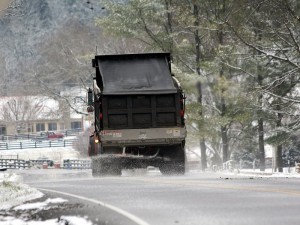US rivers need a diet of lower salt—or our drinking water will suffer
Researchers find an increase in salts and pH in nation’s waterways, putting aquatic organisms and drinking water at risk
As an Arctic blast of cold sweeps through most of the U.S., many of us see the salt trucks working hard to keep us safe—however, this generous spreading on the roads is part of a much larger problem in our water.
Roughly 37 percent of the drainage area—the land where precipitation falls off into creeks, streams, rivers, lakes—in the lower 48 states suffers from excess salts. But that’s just half the story: about 90 percent of these same drainage areas also have increased pH, which means they’re becoming more alkaline, according to a new study published in the Proceedings of the National Academy of Sciences.
These two trends can spell trouble for wildlife, drinking water pipes, and, ultimately, our health.
We’re seeing a “change in the composition of salts,” said lead author, Sujay Kaushal, a researcher and professor of geology at University of Maryland. Different salts affect the pH of water in distinct ways and there’s been an uptick in the salts that make water more alkaline, a phenomenon Kaushal and colleagues dubbed “freshwater salinization syndrome.”
It’s the first study to tease out a link between increasing salinity and pH in our waters.
They examined U.S. Geological Survey data over the past 50 years. They didn’t just look at sodium chloride, which is what we put on fries, but a whole host of different sodium ions. These “cocktails” of salts can be more toxic than just one salt, Kaushal said.
Salt content and pH are “fundamental aspects of water chemistry, so these are major changes to the properties of freshwater,” said co-author, Gene Likens, president emeritus of the Cary Institute of Ecosystem Studies and a professor at the University of Connecticut.
There is the usual culprit of those road salt spreaders, but certain building materials—such as asphalt and gypsum—also contribute salts to waterways, Kaushal said.
“And there’s a cascading affect,” he said, “adding salts to the environment accelerates the release of more salts” that are within building materials and trapped in soils.
Elevated salinity and pH is a double-whammy: both can kill aquatic organisms. High salinity can trigger the release of toxic metals, carbon, nitrogen and phosphorous from nearby soils into streams.
Elevated pH and too much salt in water can also put our drinking water infrastructure at risk—making water more corrosive to surrounding pipes and allowing metals to leach into drinking water (such as what happened in Flint). Salts also can coat the linings of pipes, Kaushal said, and, if they build up, can constrict the flow of water.
High salt in water can spur high blood pressure in people on sodium-restricted diets.
“Given increasing impacts on ecosystems and human welfare, increased salinization and alkalinization of freshwater is now a pervasive water quality issue,” the authors wrote.
Some of the nation’s biggest rivers—including the Mississippi, Hudson, Potomac, Neuse and Chattahoochee rivers—had the most dramatic changes in salts and pH. The researchers point out that many of these rivers are also drinking water sources.
The U.S. Environmental Protection Agency does not regulate salts as drinking water contaminants.
Kaushal said there are some solutions, such as more discriminate, accurate spreading of fertilizers and road salts, or, for road salt, applying it as brine prior to big snows. “We have to maintain safety on our roads, but can we do this more efficiently?” he questioned, adding that some states and communities have started using organic de-icers and mixing salts with beet juice and sugars.
One way to prevent degrading building materials from releasing salts into water would be to regulate how close roads and developments are to waterways, he said.
Source: Environmental Health News.





